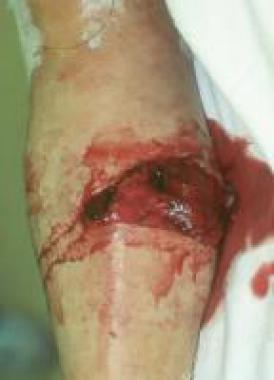

Because the tibia is a subcutaneous bone, tibial fractures are frequently open fractures (see the image below). When an individual presents with an open tibial fracture, the physician strives to save the life of the patient and the limb, to unite the fracture, and to prevent infection. Maintaining a functional limb is the goal; when that is not possible, the physician must consider amputation.
 Open tibial fracture.
Next
Open tibial fracture.
Next
Motor vehicle accidents, skiing accidents, and high-energy falls are the common causes of open tibial fractures. The mechanism of injury determines the fracture configuration (eg, skiing injuries typically cause spiral fractures). Most fractures are comminuted. Pedestrians who are hit in the upper and middle one third of the tibia sustain bumper injuries. Distal tibial and plafond fractures are commonly a result of a fall from a significant height.
Behrens et al reported an incidence of 2 open tibia fractures per 1000 injuries per year in a defined population group in an industrialized western society; this is 0.2% of all injuries.[1, 2] The incidence and severity may be even higher in the developing world.
The Gustilo-Anderson classification system (see Presentation) is a good prognostic indicator. The higher grades of injury (eg, type III fractures) are commonly associated with infection and nonunion.
Gougoulias et al reviewed 14 studies for data on management of open tibial fractures in children. They found that patients older than 10 years and those with grade II, or severe, open fractures had complications and outcomes similar to those that occur in adult patients. They found no clear effect of any particular fracture fixation method on time to union. They suggested based on the evidence that adolescents may best be managed as adults.[3]
In another study of open tibial fractures in the pediatric population, Baldwin et al performed a review of the literature to help determine the risk of infection and time to union with various fractures and current treatment. They found that over the past three decades, no significant changes occurred in management of type I and III fractures, but type II fractures were increasingly likely to be treated by closed procedures. Type III fractures were associated with a 3.5-fold and 2.3-fold greater risk of infection than type I and II fractures, respectively, but there was no significant difference in infection risk between types I and II. Mean time to union increased with increasing severity of injury, from type I to II to III.[4]
Giannoudis et al performed a questionnaire study with 130 patients treated for tibial injury (33 patients with compartment syndrome [no underlying fracture], 30 with closed diaphyseal tibial fractures, 45 with grade IIIB/IIIC open fractures, and 22 requiring below-the-knee amputation) to measure long-term functional outcome and health-related quality of life. Those with reconstructed IIIB fractures reported problems with pain and carrying out normal activities at a higher rate than amputees and problems with mobility as frequently as amputees. In those with open fractures and amputees, anxiety, depression, and problems with self-care were more common. Injury type, in general, was significantly predictive of all measured outcomes except self-care.[5]
In addition, Giannoudis et al performed a systematic review of the literature concerning the efficacy and safety of plating for open fractures of the tibial diaphysis, which has been considered controversial.[6] They found that overall union rate ranged from 62-95%; time to union ranged from 13-42 weeks; reoperation rate ranged from 8-69%; and a pooled estimate of deep infection rate was calculated at 11%. The authors suggested that plate fixation for open tibial fractures may be considered under specific conditions but that well-designed clinical trials still need to be conducted.
In a study that used the Hamlyn Mobility Score to assess return of functional mobility after open tibial fracture, Kwasnicki et al found that most of patients' recovery was completed within 3 months in cases of grade I Gustilo-Anderson fracture, within 6 months in cases of grade II fracture, and within 9 months in cases of grade III fracture.[7] Whereas the quality of walking improved up to 12 months after operation, the capacity to walk reached a plateau after 6 months.
Clinical Presentation
Copyright © www.orthopaedics.win Bone Health All Rights Reserved